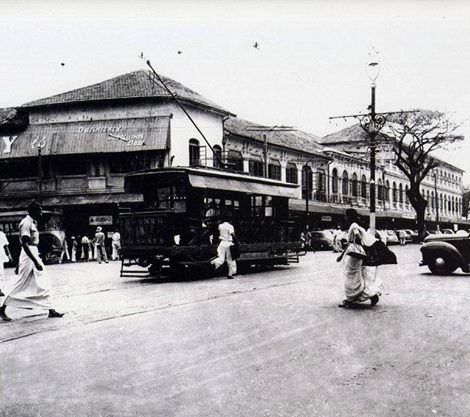In 1658, the transportation system in Ceylon changed with the capture of the Europeans. The transport system rapidly changed during the 20th century, because of plantation agriculture. Public transport in Sri Lanka goes back to British times. They laid the foundation for modern public transport in Ceylon. All coffee and plantation supplies were transported in bullock carts during the British period. Horse carts were frequently used by people of high caste and the government officials of higher rank. In 1893, the rickshaw was introduced. By 1896, pedal bicycles were seen. The railway system also began in 1864 with the track from Colombo to Ambepussa in the hill country. The railway network spread across the land. Accordingly, train, motor bus, trolley bus, motor lorry, motor car and tramcars were the popular modes of transportation of both, passengers and goods.
The tramcar system was introduced in many countries in the beginning of the 20th century. Then it came to Ceylon. During this time, the population of Colombo increased, because Colombo, over the years had been the administrative and commercial centre. Colombo city rapidly developed economically at this time. Therefore, it was a very busy city, because the Port, schools, banks, shops, government offices, main hospitals and various educational institutions were available here. Hence, many people came to the Colombo city for their work.
In 1892 the Colombo Municipal Council called for tenders for the construction of tramways in the city. Three years later a contract was signed with a private sector firm, ‘Boustead Brothers’. Work on laying the tracks, overhead construction and the power station commenced in September 1897
The Ceylon Electric Tramways were opened for traffic on January 11, 1900, with the Grand Pass Route being the first section to open, followed by the Borella (Maradana) Route. Later most parts of the city was covered and it became a convenient mode of transport to city dwellers. Despite the statement that five routes were planned and that most parts of the city would be covered, no records have been found to substantiate further expansion of the Colombo Tramway








Tramways in Colombo, c.1920 

The tramways was eventually brought under Colombo Electric Tramways and Lighting Company Ltd (Boustead Brothers). after its formation in 1902, the same company that built the Pettah Power Station. The Pettah Power Station was the second power station established in the country and was used to power the tram network, mercantile offices, government buildings and street lights.
The whole of the track on both routes was relaid with 43 kg (95 lb) rails between December 1905 and August 1907, with all joints being welded by thermite process.
The tram network consisted of a single 12 km (7 mi) line which utilised a 42 in (107 cm) rail gauge. A total of 52 cars were in service, shuttling thousands of passengers between ten stops on the route from Maradana Station to Borella. The trams used trolley poles and consisted of open “toast-rack” type, and closed centre-entry type.
Tram routes in lighter black with lines crossing periodically
Railways in a darker colour solid line
The average number of passengers carried on both routes in 1900 was 14,529 daily. In 1905, the number of passengers carried was 6,555,338 compared with 6,599,059 during 1904. It seems, tramcars were very popular among the people.
Grand Pass Route
- Fort Terminus (opposite Grand Oriental Hotel)
- Coal Depot
- Pettah Market
- Main Street
- St Paul’s Church
- New Moon Street
- Messenger Street
- Grand Pass Road
- St Joseph’s College
- Grandpass
- River Kelani
Borella Tramway
- Fort Terminus (opposite Grand Oriental Hotel)
- York Street
- Chatham Street
- North Road
- Fort Railway Station
- Lake and Royal College
- Ferry terminal to Captain’s Garden
- Railway Goods Station
- Technical College
- Pass over railway at Maradana Junction
- Police Headquarters
- Maradana Road
- Borella
In 1929, a tram strike occurred, and 225 workers including drivers stopped the tram service because they were not paid enough.
While countries including Australia still run tramcars in cities like Melbourne, Colombo’s tramcars disappeared. On November 11th 1943, the Municipal Council decided to give notice to the Tramway Company of its intention to purchase the tramways. In 1944, arrangements had been made to take over possession of the tramways on November 25. The tramcar service in the Colombo city was operated by the Colombo Municipal Council between 1944 and 1960.
The advent of personal motor vehicles and improvements in motorized buses caused the rapid disappearance of the tramcar from most Western and Asian countries by the end of the 1950s. Trolley systems also were introduced to the world in the 20th century. Tramcars disappeared from many countries in the middle of the 20th century. Likewise, in Ceylon, tramcars stopped running somewhere in the 1950s. The tram service was stopped completely after the trolley bus service was introduced in 1953.
Credit – Wikipedia, Sunday Observer, FIBI Wiki

















Loading…
Loading…